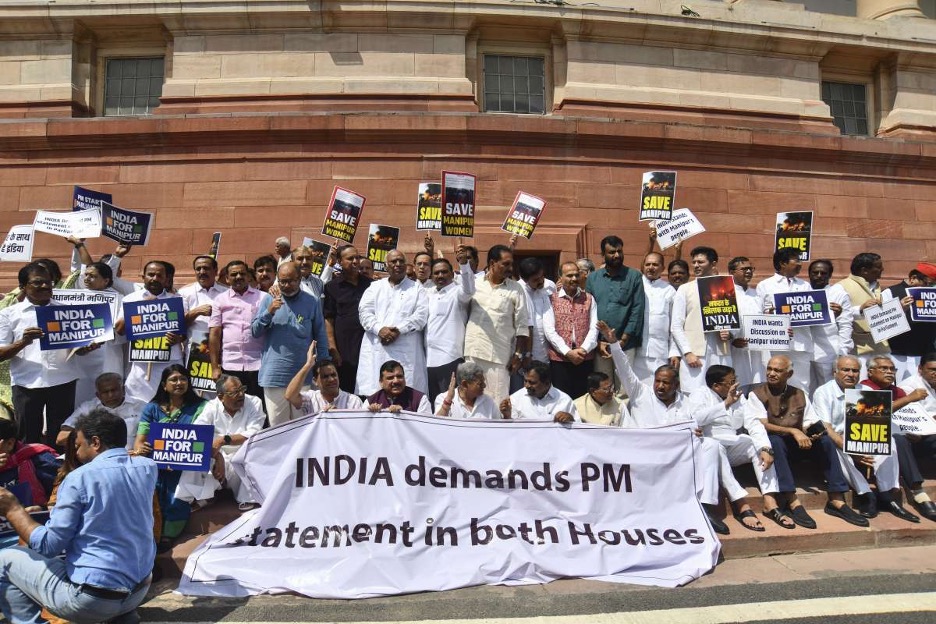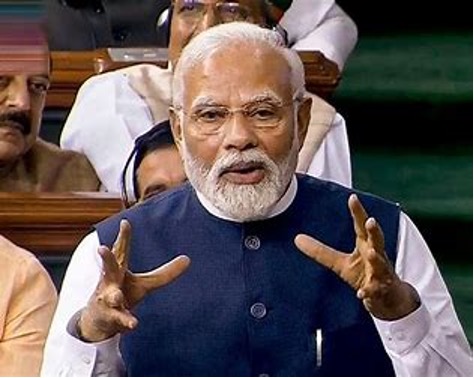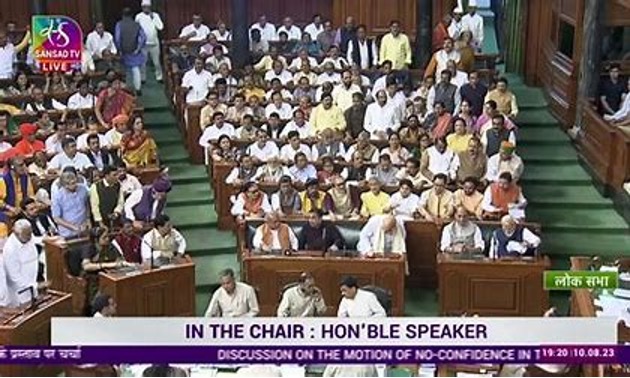Recently, during the Monsoon session, the Council of Ministers was surprised to witness the thunder of a no-confidence motion moved against them by the opposition. The ruling government has been in power since 2014, winning a landslide victory in 2019 for the second time. Even though the no-confidence motion introduced by I.N.D.I.A (Indian National Developmental Inclusive Alliance) was defeated by a voice vote, it proves an important point.
A motion of no-confidence can be introduced for one of two purposes- to dissolve the government citing inefficiency, or to discuss important issues. The latest motion intended to highlight the government’s failure to control the ongoing violence in Manipur, which has succumbed to ethnic strife between the Kuki and Meitei communities, resulting in public clashes, mob violence, crimes against women and hundreds of deaths as law and order collapsed. Even without the numbers in the Lok Sabha required for the motion to pass, the no-confidence move of the opposition has been termed a strategic one by observers in light of the Manipur violence and the government’s hesitancy to discuss it extensively

A no-confidence motion is a mechanism that can be formally introduced by members of the opposition against the government under Rule 198 (Rules of Procedure and Conduct of Business in Lok Sabha). This motion is important because in a parliamentary democracy (such as India), a government can only stay in power as long as it enjoys the consent of the majority. It must be noted that a no-confidence motion can only be introduced in the Lower House of the Parliament (Lok Sabha or House of the People). Any member of the Lok Sabha can introduce the motion at any time, but he/she must have the support of at least 50 members. If a number of people’s representatives feel that the government is not working up to standard, a no-trust vote can be introduced.
Though the Constitution does not explicitly specify a confidence or no confidence motion, it does mention the principle of collective responsibility. Article 75 (3) of the Indian Constitution maintains that the Prime Minister and the Council of Ministers are ‘collectively responsible’ to the people. If a no-confidence motion is passed by a simple majority in the house of the directly elected representatives, the Prime Minister and the entire Council of Ministers must resign, and the government is dissolved. The motion is considered defeated if the Prime Minister is able to prove a majority in the house. In simpler words, it can be said that no government elected by the people can exercise absolute power because it is elected for the people. Once it loses the faith of the people, it can just as easily be removed from power. Therefore, a no-confidence motion is a highly potent weapon entrusted to the opposition. The threat of a no-confidence motion creates a system of checks and balances in the legislature and ensures a ‘floor-test’ of the government.

The Speaker grants the leave to move a no-confidence motion. The member of Lok Sabha who wants to move a no-confidence vote is required by the rules to provide a written notice to the Secretary General of the Lok Sabha before 10 am on the day the motion is proposed to be moved. Once a motion of no-confidence is introduced, the Speaker of the Lok Sabha has the prerogative to accept or reject it. If it is admitted, days or a part of a day is allotted for discussion, keeping in mind that it does not hinder regular business of the House. A debate ensues (within 10 days) where both the opposition and the ruling party have the right to present their allegations and defences at length. After the debate is over, a vote takes place which decides the future of the administration.
Historically, 27 no-confidence motions have been initiated barring the latest one. The first such motion was introduced by Parliamentarian Acharya JB Kriplani against the Nehru-led Congress government in 1963 in the aftermath of the humiliating defeat of India in the Indo-China War (1962). Most motions of no-trust have either been defeated or remained inconclusive.
The most recent no-confidence motion was the second faced by the Narendra Modi government (the first one being in 2018). It witnessed three days of passionate debates by both sides and culminated with a long address by the Prime Minister in the House.

The opposition launched sharp attacks on the government and staunchly condemned the violence in Manipur. They shot tough questions regarding the failure of the government to act swiftly considering they had a “double-engine setup” and all the resources of the Union and the State at their disposal. Moreover, they also raised numerous other serious issues like inflation, unemployment and religious hatred that have worsened in the 9 years of the incumbent regime. Congress leader Rahul Gandhi attacked the Treasury benches viciously, so much so that some parts of his speech were expunged from records. TMC MP Mahua Moitra pointed out that (the people of) India would not remain silent anymore and criticised the “whataboutery and false equivalences” of the current dispensation.
The members of the House from the ruling side defended the Council of Ministers by questioning the motives of the opposition and cited failures of previous regimes, mainly during the Congress era. Most of the speeches from the defending side highlighted that the no-confidence motion was politically motivated. Moreover, they claimed that the opposition, unlike the government, is corrupt and engages in dynastic politics. Home Minister Amit Shah in his speech focused on the issues of violence in Manipur and terrorism in Kashmir and called out the opposition for using these issues for cheap political stunts at the expense of national security. Ministers Smriti Irani, Nirmala Sitharaman and Jyotiraditya Scindia were also instrumental in attacking the motive of the motion.
After fiery allegations and strong defences, the Prime Minister showed up in the Lok Sabha amidst loud cheers and sloganeering from partisans. He began his address by commenting that the motion of no-confidence was indeed auspicious for the Council of Ministers as it gave them a chance to present their achievements at length. Accusing the opposition on various fronts, the PM mocked the political gimmick of those who introduced the motion throughout his speech. He asserted that the NDA government had launched a series of successful people-oriented schemes since they were voted to power and highlighted spectacular achievements, notably that of “Digital India” and “Make in India”.
He also proudly claimed to have restored and even heightened the international glory of India. He vehemently blamed the politics of Congress for ruining the country and reaffirmed his fidelity to restore peace in all violence-hit regions. The opposition, miffed by the Prime Minister’s mockery and circumventing the hot issue of ethnic violence and women’s security in Manipur, staged a walkout without waiting for the address to be concluded.
Finally, the no-confidence motion was subjected to voice vote and consequently defeated.

The entire political spectacle was a significant move in light of the approaching national elections next year. Both sides used the motion as an opportunity to put forward their views and hopes for India in the near future. For those who closely followed the debate, it provided a much-needed insight to clear the haze around their vision for the forthcoming ‘festival of democracy’. The no-confidence motion was also a reminder that in a people’s rule, the opposition may be weak, but never non-existent. The dynamism of the motion forced the government to come forward and speak about the violence in Manipur which they might have avoided otherwise. The opposition’s voice remains a crucial element in shaping the nation’s discourse.
In conclusion, the no-confidence motion serves as a reminder of the vibrancy of democracy and the multifaceted nature of political engagement in India.
Written by – Kashvi
Edited by – Anushka Bhutani
